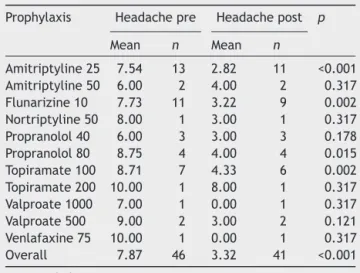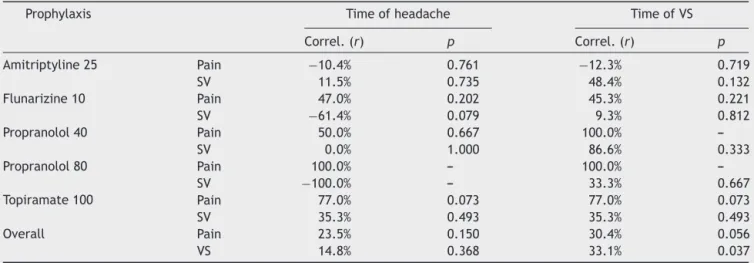www.bjorl.org
Brazilian
Journal
of
OTORHINOLARYNGOLOGY
ORIGINAL
ARTICLE
Prophylactic
treatment
of
vestibular
migraine
夽
Márcio
Cavalcante
Salmito
∗,
Juliana
Antoniolli
Duarte,
Lígia
Oliveira
Golc
¸alves
Morganti,
Priscila
Valéria
Caus
Brandão,
Bruno
Higa
Nakao,
Thais
Rodrigues
Villa,
Fernando
Freitas
Gananc
¸a
UniversidadeFederaldeSãoPaulo(UNIFESP),DepartamentodeOtorrinolaringologiaeCirurgiadeCabec¸aePescoc¸o,SãoPaulo, SP,Brazil
Received27January2016;accepted19April2016 Availableonline2June2016
KEYWORDS Dizziness; Vertigo; Migraine; Prophylaxis; Treatment
Abstract
Introduction:Vestibularmigraine(VM)isnow acceptedasacommoncauseofepisodic ver-tigo.TreatmentofVMinvolvestwosituations:thevestibularsymptomattacksandtheperiod betweenattacks.Forthelatter,someprophylaxismethodscanbeused.Thecurrent recom-mendationis to use thesame prophylacticdrugs used for migraines, including -blockers, antidepressants andanticonvulsants.Therecentdiagnosticdefinition ofvestibularmigraine makesthenumberofstudiesonitstreatmentscarce.
Objective:To evaluate the efficacy of prophylactic treatment used in patients from a VM outpatientclinic.
Methods:Reviewofmedicalrecords frompatientswith VM accordingtothecriteriaofthe BáránySociety/InternationalHeadacheSocietyof2012criteria.Thedrugsusedinthe treat-ment and treatment response obtained through the visual analog scale (VAS) for dizziness and headache were assessed. The pre andpost-treatment VAS scores were compared (the improvementwasevaluatedtogetherandindividually,perdrugused).Associationswithclinical subgroupsofpatientswerealsoassessed.
Results:Of the 88 assessed records, 47 were eligible. We included patients that met the diagnostic criteria for VM and excluded those whose medical records were illegible and those of patients with other disorders causing dizziness and/or headache that did not meet the2012criteriafor VM.80.9% ofthepatients showedimprovementwithprophylaxis (p<0.001).Amitriptyline,Flunarizine,PropranololandTopiramateimprovedvestibular symp-toms (p<0.001) and headache (p<0.015). The four drugs were effective in a statistically significantmanner.Therewasapositivestatisticalassociationbetweenthetimeofvestibular symptomsandclinicalimprovement.Therewasnoadditionalbenefitinhypertensivepatients whousedantihypertensivedrugsasprophylaxisordepressedpatientswhousedantidepressants inrelationtootherprophylacticdrugs.Drugassociationdidnotshowstatisticallysignificant resultsinrelationtotheuseofasingledrug.
夽 Pleasecitethisarticleas:SalmitoMC,DuarteJA,MorgantiLO,BrandãoPV,NakaoBH,VillaTR,etal.Prophylactictreatmentofvestibular
migraine.BrazJOtorhinolaryngol.2017;83:404---10.
∗Correspondingauthor.
E-mail:marciosalmito@yahoo.com(M.C.Salmito).
PeerReviewundertheresponsibilityofAssociac¸ãoBrasileiradeOtorrinolaringologiaeCirurgiaCervico-Facial.
http://dx.doi.org/10.1016/j.bjorl.2016.04.022
Conclusions: ProphylacticmedicationsusedtotreatVMimprovethesymptomsofthisdisease, butthereisnostatisticallysignificantdifferencebetweentheresponsesofprophylacticdrugs. Thetimeofvestibularsymptomseemstoincreasethebenefitwithprophylactictreatment. © 2016 Associac¸˜ao Brasileira de Otorrinolaringologia e Cirurgia C´ervico-Facial. Published by Elsevier Editora Ltda. This is an open access article under the CC BY license (http:// creativecommons.org/licenses/by/4.0/).
PALAVRAS-CHAVE Tontura;
Vertigem; Enxaqueca; Profilaxia; Tratamento
Tratamentoprofiláticodamigrâneavestibular
Resumo
Introduc¸ão: A migrânea vestibular (MV) é aceita atualmente como uma causa comum de vertigemepisódica.OtratamentodaMVenvolveduassituac¸ões:ascrisesdesintomas vestibu-lareseoperíodointercrise.Paraesteúltimo,pode-seutilizaralgummétododeprofilaxia.A recomendac¸ãoatual équeseutilizemos mesmosmedicamentosprofiláticosutilizadospara aenxaqueca,oqueincluios-bloqueadores,antidepressivoseanticonvulsivantes.Arecente definic¸ão diagnóstica da migrâneavestibular torna escasso o número de estudos sobreseu tratamento.
Objetivo: Avaliaraeficáciadotratamentoprofiláticoutilizadoempacientesemumambulatório deMV.
Método: Revisão de prontuários de pacientes com MV pelos critérios da Bárány Soci-ety/InternationalHeadeacheSocietyde2012.Forampesquisadososmedicamentosutilizadose respostaaotratamentoobtidaatravésdaescalavisual-analógica(EVA)paratonturaecefaleia. ForamcomparadososescoresdaEVApréepós-tratamento(amelhorafoiavaliadaemconjunto e individualmentepordrogautilizada).Tambémforampesquisadas relac¸ões comsubgrupos clínicosdospacientes.
Resultados: De 88 prontuários estudados, 47 foram elegíveis. Incluiu-se os pacientes que preenchiamoscritériosdiagnósticosparaMV,foramexcluídososprontuáriosilegíveise aque-lesdepacientescomoutrodistúrbiocausadordetonturae/ou cefaleiaquenão preenchiam critérios de 2012 para MV. Apresentaram melhora com a profilaxia 80,9% dos pacientes (p<0,001). Amitriptilina,flunarizina, propranolole topiramato apresentaram melhorapara sintomas vestibulares(p<0,001)epara cefaleia(p<0,015).Osquatro medicamentosforam eficazesdeformaestatisticamentesignificante.Houverelac¸ãoestatísticapositivaentretempo desintomavestibularemelhoraclínica.Nãohouvebenefícioadicionalparahipertensosque utilizaram anti-hipertensivoscomo profilaxia ouparaos deprimidosqueusaram antidepres-sivosem relac¸ãoaousodosoutrosprofiláticos.A associac¸ãodemedicamentosnãomostrou resultadosestatisticamentesignificantesdousodeummedicamentoisolado.
Conclusões: Os medicamentos profiláticos utilizados para MV melhoram os sintomas dessa doenc¸a,porémnãohádiferenc¸aestatisticamentesignificanteentreasrespostasdos medica-mentos profiláticos.Otempode sintomavestibular pareceaumentarmelhoraobtida como tratamentoprofilático.
© 2016 Associac¸˜ao Brasileira de Otorrinolaringologia e Cirurgia C´ervico-Facial. Publicado por Elsevier Editora Ltda. Este ´e um artigo Open Access sob uma licenc¸a CC BY (http:// creativecommons.org/licenses/by/4.0/).
Introduction
Dizziness is one of the most common symptoms in medi-cal practice,with an incidence of up to30% a year and, despiteitsdifficultapproach,itisusuallypossibletoreach a diagnosis.1,2 Vestibular disorders are the main diseases thatmanifestwithdizzinesscomplaintsand,amongthem, the most common are Benign Paroxysmal Positional Ver-tigo(BPPV),VestibularMigraine(VM),Meniere’sdiseaseand vestibularneuritis,indecreasingorderoffrequency.2
Migraine is a multifactorial chronic disease. Its main symptom is headache, typically unilateral, pulsatile,
proposed by Neuhauser in 20018 and revised in 2012 by the Bárány Society and the International Headache Soci-ety (IHS),9 and was included in the third version of the InternationalClassificationofHeadacheDisorders---ICHD.10 The VM is now accepted as a frequent cause of episodic vertigo.
Treatment of VM involves twosituations: treatment of attacks and prophylactic treatment. Forthe latter, some type of prophylaxis can be used.11,12 The current recom-mendationistousethesameprophylacticdrugsfor VMas formigraine,whichinclude-blockers,antidepressantsand anticonvulsants.11---13
Theaimofthisstudywastoevaluatetheimprovement inVMsymptoms(headacheandvestibularsymptoms)after drugprophylaxisinpatientswithVM,treatedataVMclinic belongingtotheDisciplineofOtoneurology.
Methods
Anobservational,longitudinal,retrospectivestudyof medi-calrecordreviewwascarriedout.Weevaluatedtherecords of all patients treated at the Vestibular Migraine Outpa-tient Clinic of the Discipline of Otology and Neurotology, Departmentof OtolaryngologyandHeadandNeckSurgery oftheUniversidadeFederaldeSãoPaulosinceitscreationin February2011untilJune2013.Thisstudywasapprovedby theResearchEthicsCommitteeoftheUniversidadeFederal deSãoPaulo(code19615313.13.5.0000.5505).
Thediagnosticcriteriaforvestibularmigraineusedwere the criteria proposed in 2012 by the Bárány Society and theInternational HeadacheSociety(IHD),9 includedinthe thirdversionoftheInternationalClassificationofHeadache Disorders --- ICHD.10 It included patients with ‘‘vestibular migraine’’ and ‘‘probable vestibular migraine.’’ As the Vestibular Migraine Outpatient Clinic of this Universidade FederaldeSãoPaulowascreatedin2011,informationfrom medicalrecordswasindividuallyreviewedandpatientswho metthe2001criteriaforVM, butnotthenew2012 crite-ria, or those showing dubious informationabout it, were excluded.
Due to the wide variation in the literature regarding the terms used in otoneurology (dizziness, vertigo, etc.), in this article we decided to use the terms proposed for the‘‘ClassificationofVestibularSymptoms’’,bytheBárány Societyin2009.14
Although itis anambulatory care clinic,the vestibular migraineoutpatientclinic wascreated in order tobetter understand this disease, which, even though having been describedonlyin1999,iscurrentlythesecondmostfrequent diagnosisofvestibulardiseases.Thepatientstreatedatthe clinicarethosewhometthe diagnosticcriteriaandwere referredfrom theotoneurology clinic. Each clinic patient hadastandardized questionnairecompletedbythe exam-inerateachvisit.Amongotherthings,theoutpatientclinic patientsareaskedtoanswertwoquestionsatevery consul-tation:‘‘Haveyouimprovedwithtreatment?’’and‘‘Givea scorefrom0to10foryoursymptoms,where0isthe min-imum, or best possible and 10 is the maximum, or worst possible.’’Ateach consultation,patientsaretreated dur-ingthenormalroutineoftheclinic,byresidentsorfellows ofotoneurology,supervisedbyasingleadvisor.
We included all records of patients with vestibular migraineandthefollowinginformationwasconsidered:
- Epidemiologicaldata:name,gender,age,professionand placeofbirth.
- Clinicalcharacteristicsofthedisease. - Pastmedicalhistory.
- Resultsofthetreatmentsevaluatedthroughthegeneric question ‘‘Have you improved with treatment?’’ and throughtheVisualAnalogScale(VAS).
Filesofpatientswithanotherdisordercausingdizziness and/orheadache,thosewhodidnotmeetthe2012criteria forVM andthosewithillegiblerecordsorwithincomplete orconflictinginformationwereexcluded.
Eachpatientwasevaluatedthroughthe VASforthe 30 days prior to prophylactic treatment and VAS for three months after the beginning of prophylactic treatment with different drugs. The VAS was applied to the symp-tom headache and Vestibular Symptoms (VS). Vestibular symptomsvariedsomewhatamongpatients.Somehad spon-taneousvertigo,otherspositionalvertigo,whileothershad vestibular-visual symptoms. Due to this variation, these symptomsweregroupedasVS.
Clinicalimprovementwasdeterminedbythedifference betweenthesescores,calledtherapeuticresponse.Incase of need for treatment change due todrug failureor side effects,orforfinancialreasons,theinitialdrugwaschanged to a second medication. At the VM outpatient clinic, the choiceofdrugsisbasedonthepatient’sprofileandchoice, for example, antidepressants for those with anxiety and antihypertensiveagentsforthosewithassociated hyperten-sion.
The periodofthree monthsbetween theinterventions (definition ofimprovement/failure)wasdeterminedbased onthefactthatthetherapeuticeffectofdrugsonlybegins after2---4 weeksandthefactthatthediseasehasnatural periodsofimprovementandworseningandthatpatients,in agivenmonth,canhavemoreorfewercrisesduetonatural episodicnatureofthediseaseandnotduetoreal improve-ment/worsening. Allpatients receive the sameadvice on thebenefitsofeatinghabits,sleephygiene,physical activ-itypracticeandidentificationandinterruptionofmigraine triggers.
Pre-andpost-treatmentgainvalueswerecomparedusing the Kruskal---Wallis test. Other statistical tests used were theequalproportionstestandSpearman’scorrelationtest. Differences were considered statistically significant when p<0.05fora95%confidenceinterval.
Results
Epidemiologicalresults
Table1 Ageanddurationofsymptoms(years)inpatients withVM.
Age Timeheadache TimeofVS
Mean 45.9 10.8 6.0
Median 47.5 7.0 4.0
Deviation 10.9 11.0 6.5
Minimum 19 1.0 0.3
Maximum 69 50 30
n 46 46 47
VM,vestibularmigraine;VS,vestibularsymptoms.
Table2 ComorbiditiesinpatientswithVM.
Disease n %
None 15 31.9
SAH 15 31.9
DM 2 4.3
Dyslipidemia 9 19.1
Epilepsy 2 4.3
Hypothyroidism 6 12.8
Anxiety/depression 8 17.0
Others 14 29.8
VM,vestibularmigraine; SAH,systemic arterialhypertension; DM,diabetesmellitus.
Table3 ClinicalimprovementinpatientswithVM.
Improved? Yes p
n %
Amitriptyline25 10 76.9% 0.006 Amitriptyline50 2 100% 0.046 Flunarizine10 10 90.9% <0.001 Nortriptyline50 1 100% a
Propranolol40 2 66.7% 0.083
Propranolol80 4 100% 0.005
Topiramate100 4 57.1% 0.094
Topiramate200 1 100% a
Valproate1000 1 100% a
Valproate500 2 66.7% 0.083
Venlafaxine75 1 100% a
Overall 38 80.9% <0.001
VM,vestibularmigraine.
a pnotcalculatedduetosmalln.
thepatients’recordsandcouldnotbeobtained byphone contact.Becauseofthis,somedataappearwithadifferent numberfromtheoriginal47(Table1).Therewasa predom-inanceofwomen(93.6%).Nearlyathirdofpatientsdidnot haveanycomorbidityand,amongthosewithcomorbidities, hypertensionwasthemostprevalentone(Table2).
Benefitsofdrugprophylaxis
Mostofthepatients(80.9%)reportedimprovementwiththe useofdifferentprophylacticdrugs(Table3),witha statis-tically significantdifference(p<0.001)whencomparedto thosewhosaidtheyhadnotimproved.
Table 4 Values obtained with the visual analog scale for headaches, beforeandafter useofprophylacticdrug, accordingtothedrugusedinpatientswithVM.
Prophylaxis Headachepre Headachepost p
Mean n Mean n
Amitriptyline25 7.54 13 2.82 11 <0.001 Amitriptyline50 6.00 2 4.00 2 0.317 Flunarizine10 7.73 11 3.22 9 0.002 Nortriptyline50 8.00 1 3.00 1 0.317 Propranolol40 6.00 3 3.00 3 0.178 Propranolol80 8.75 4 4.00 4 0.015 Topiramate100 8.71 7 4.33 6 0.002 Topiramate200 10.00 1 8.00 1 0.317 Valproate1000 7.00 1 0.00 1 0.317 Valproate500 9.00 2 3.00 2 0.121 Venlafaxine75 10.00 1 0.00 1 0.317 Overall 7.87 46 3.32 41 <0.001
VM,vestibularmigraine.
Table5 Valuesobtainedwiththevisual analogscalefor vestibular symptoms,before andafter useofprophylactic drug,accordingtothedrugusedinpatientswithVM.
Prophylaxis VSpre VSpost p
Mean n Mean n
Amitriptyline25 6.38 13 2.55 11 0.001 Amitriptyline50 6.50 2 2.50 2 0.221 Flunarizine10 6.82 11 4.56 9 0.050 Nortriptyline50 8.00 1 2.00 1 0.317 Propranolol40 6.33 3 4.00 3 0.197 Propranolol80 7.75 4 3.25 4 0.034 Topiramate100 8.29 7 3.33 6 0.006 Topiramate200 7.00 1 0.00 1 0.317 Valproate1000 5.00 1 0.00 1 0.317 Valproate500 7.50 2 2.00 2 0.121 Venlafaxine75 10.00 1 0.00 1 0.317 Overall 7.04 46 3.05 41 <0.001
VM,vestibularmigraine;VS,vestibularsymptoms.
When quantitatively evaluating the VAS values for headache and vestibular symptoms, these were lower in thepost-treatmentperiod,confirmingthequalitative find-ingthattherewasclinical improvement (Tables4 and5). Allpatientsshowedimprovementforbothsymptomswitha statisticallysignificantdifference(p<0.001).
Table6 Therapeuticresponseassessedbythemean vari-ationofVASafter prophylactictreatmentinpatientswith VM.
Prophylaxis Headache VS
Mean n Mean n
Amitriptyline25 −4.82 11 −4.00 11
Amitriptyline50 −2.00 2 −4.00 2
Flunarizine10 −4.33 9 −2.56 9
Nortriptyline50 −5.00 1 −6.00 1
Propranolol40 −3.00 3 −2.33 3
Propranolol80 −4.75 4 −4.50 4
Topiramate100 −4.50 6 −5.00 6
Topiramate200 −2.00 1 −7.00 1
Valproate1000 −7.00 1 −5.00 1
valproate500 −6.00 1 −6.00 1
Venlafaxine75 −10.00 1 −10.00 1
Overall −4.53 40 −4.10 40
VAS,visualanalogscale;VM,vestibularmigraine;VS,vestibular symptoms.
Statisticalcorrelationsfortreatmentstrategies
We sought to assess whether there was an association between how much the patient improved (treatment response) and duration of symptoms, using Spearman’s correlationtest.Therewasnostatisticallysignificant asso-ciation withanygroupof drugs,but regardingtheoverall group, therewas a directly proportional and statistically significantassociation(p=0.037)betweendurationof dizzi-nessreportedbythepatientandtheobservedtherapeutic responsefortheVS,asshowninTable8.
The groupof hypertensive patientsusing-blockersas prophylactic treatment for vestibular migraine and the groupofanxious/depressedpatientsthatused antidepres-sants,however,showednostatisticallysignificantadvantage whenusingthesedruggroupswhencomparedtothoseusing otherdrugs(Tables9and10).
Therewas nostatistically significant differenceamong treatment responses obtained with the three different treatment regimens used:onedrug,onemedication after substitutionduetotreatmentfailureorthecombinationof twodrugs(Table11).
Table7 TherapeuticresponseappraisedbythemeanvariationofVASafterprophylactictreatmentinpatientswithVMper drugused.
Prophylaxis Headache VS
Mean n p Mean n p
Amitriptyline25 −4.82 11 0.977 −4.00 11 0.608
Flunarizine10 −4.33 9 −2.56 9
Propranolol40 −3.00 3 −2.33 3
Propranolol80 −4.75 4 −4.50 4
Topiramate100 −4.50 6 −5.00 6
Overall −4.53 40 −4.10 40
VM,vestibularmigraine;VS,vestibularsymptoms.
Table8 StatisticalcorrelationbetweentheresponsetotherapyassessedbyVASafterprophylactictreatmentinpatientswith VMandtimeofsymptoms(migraineandVS).
Prophylaxis Timeofheadache TimeofVS
Correl.(r) p Correl.(r) p
Amitriptyline25 Pain −10.4% 0.761 −12.3% 0.719
SV 11.5% 0.735 48.4% 0.132
Flunarizine10 Pain 47.0% 0.202 45.3% 0.221
SV −61.4% 0.079 9.3% 0.812
Propranolol40 Pain 50.0% 0.667 100.0%
---SV 0.0% 1.000 86.6% 0.333
Propranolol80 Pain 100.0% --- 100.0%
---SV −100.0% --- 33.3% 0.667
Topiramate100 Pain 77.0% 0.073 77.0% 0.073
SV 35.3% 0.493 35.3% 0.493
Overall Pain 23.5% 0.150 30.4% 0.056
VS 14.8% 0.368 33.1% 0.037
Table9 Comparisonbetweentherapeuticresponse mea-sured by VAS variation in hypertensive patients receiving -blockerdrugprophylaxisandhypertensivepatients receiv-ingotherdrugs.
Drug Responseforpain ResponseforVS
Others Propranolol40 Others Propranolol40
Mean −4.20 −3.50 −4.60 −3.50
n 10 2 10 2
p 0.914 0.746
VAS,visualanalogscale;VS,vestibularsymptoms.
Table10 Comparisonoftherapeutic responseatVASfor anxiousindividualstreatedwithantidepressantprophylaxis andVASforanxiousindividualstreatedwithotherdrugs.
Anxiety Responseforpain ResponseforVS
Others Antidepressants Others Antidepressants
Mean −3.67 −10.00 −4.17 −5.00
n 6 1 6 1
p 0.094 1.000
VAS,visualanalogscale;VS,vestibularsymptoms.
Discussion
Vestibular migraine shows a predominance of female patients,witharatioof1.5---5:1,occurringatanyageand theheadacheusuallyprecedesvestibularsymptomsinmost patients.7,15 The same was observed in this sample with. 93.6%of women,mean ageof 45.9yearsandmean dura-tionof headachelonger thanthemean timeof vestibular symptoms(Table1).
ThebenefitofdrugprophylaxisforVMisstillavastfield ofstudy.Overall,itisacceptedthattheprophylactic treat-ment for VM is effective, but there are no double-blind randomizedtrialscomparingdifferenttreatments.12,13 Due tothe recent descriptionof VM, only studies onmigraine associatedwithdizzinessorimbalancewerefoundinthe lit-erature.ReploegandGoebelreported72%ofpatientswith vertigoandimbalancesymptomsimprovedafter prophylac-tictreatment.16Similarresultswereobservedinthisstudy, inwhich80.9%ofpatientsreportedsomeimprovementwith theuseofdifferentprophylacticdrugs(Table3).
Nostudieswerefoundcomparinggroupsofprophylactic drugsinpatientswithdiagnosticcriteriaforVM.Evenreview articlesonthistopicfailedtoreachconclusionsaboutthe bestdrugchoiceforprophylaxis.12,13,17
Thetherapeuticresponsetoepisodic disorders,suchas Meniere’sdiseaseorvestibularmigraineismoredifficultto studyduetonaturaldiseasefluctuations.Disease improve-mentafteronemonth,forinstance,maybeduetoanatural asymptomatic period, rather than due to a therapeutic effectof an intervention.The longertheperiodof evalu-ationoftherapeuticresponse,themorereliableitwillbe. The3-monthperiodusedinthisstudywasempirically cho-sen,respectingtheminimumof2---4weeksfordrugaction onsetandadding2moremonths.Durationlongerthanthe 3-monthperiodcouldleadtoloweradherencetotreatment bypatients.
This study alsoshowed quantitativebenefits withdrug treatmentforVMprophylaxis,whenusingtheVAS.Despite theimperfectionsofthisassessment method,somethings may be postulated. There was a statistically significant improvement in headache and VS, but some drugs alone showedimprovement withnosignificant difference. Daily dosesof25mgofamitriptyline;10mgofflunarizine;80mg ofpropranololand100mgoftopiramateshowedsymptom improvementwith statisticallysignificant difference. It is noteworthythat this occurred alsofor both the symptom ofheadacheandfor theVS, and,likewise,the drugsthat showed no statistical difference for vestibular symptom improvementwerethesamethatshowednoimprovement forthesymptomofheadache.
Improvement without statistical significance was observed for amitriptyline 50mg and topiramate 200mg; although smaller doses have shown a significant improve-ment,thatmust beduetothefactthatthesedoseswere used precisely in patients who did not respond to lower doses,that is, these werepatients with refractory symp-toms, despite the small sample size. As for nortriptyline 50mg;valproate 500---1000mg, and venlafaxine75mg,the low number of patients in the sample may have been responsible for the nonsignificant improvement. Finally, propranololseemstorequireahigherdose(80mg/day)to showimprovement.
The improvement in VASvalues wassimilaramongthe differentdrugs used(Table7).Thiscanbeseen asa posi-tiveresult,asalldrugsledtoanimprovementsubjectively perceivedbythepatient,both fortheheadachesymptom andtheVS.Itremains,however,difficulttochoosethebest
Table11 ComparisonofthetherapeuticresponsesmeasuredbyVASamongthethreetreatmentregimensused:amedication, asubstitutemedicationafterthefailureofthefirstoneandassociationoftwodrugs.
Regimen Mean n p
Therapeutic responsefor headache
Onemedication −4.53 41 0.174
Asubstitutemedication −3.50 15
Associationoftwomedications −2.50 7
Therapeutic responseforVS
Onemedication −4.10 41 0.093
Asubstitutemedication −2.21 15
Associationoftwomedications −4.67 7
optionfordifferentpatientswithVMandthechoiceismade accordingtopossibledrugcontraindicationsorinteractions withothermedicationsthatpatientsarealreadyusing, try-ingtooptimizepatientdrugtherapy.
According to a study by Bikhasiet al.,18 the temporal association between dizziness and migrainedid not influ-encetheefficiencyofprophylactictreatment.Inthisstudy, however,astatisticallysignificantassociationbetween dura-tionofdizzinessandtherapeuticresponsefordizzinesswas observed(p=0.037).Thedurationofdizzinessalsoshowed a tendency toward a negativeassociation for therapeutic responseforheadache(p=0.056).Thisshowsthatthelonger the duration of VS experienced by the patient, the bet-terthetherapeuticresponseprovidedbyprophylacticdrug therapy.Specific studies onthis topicare needed to bet-teranswer the question ‘‘Does the duration of vestibular symptomsinfluencetheeffectivenessofdrugprophylaxis?’’ Thechoiceofprophylacticdrugisbasedonthepatient’s profileor comorbidities(antidepressantsforpatients diag-nosed with anxiety, for instance), with no particular advantageofonegroupofdrugsovertheothers.11---13,17Inthe currentsample,thegroupofhypertensivepatientswhoused beta-blockersasprophylaxisfor VMandthe groupof anx-ious/depressed patientswhousedantidepressantsdidnot showanystatisticallysignificantadvantagewiththeuseof thesedruggroupscomparedtothosewhousedotherdrugs. Thisfactdoesnotinvalidatethecurrentrecommendations forthechoiceofprophylacticdrugs;however,itraisesthe suspicion(giventhesmallsamplesize)thatthereisno par-ticularadvantageinimprovingVM symptoms.Naturally,in thecontextofrationaldruguse,itismoreappropriatetouse asingledrugthatiseffectivefortwopatientcomorbidities thantheuseofonedrugforeachdisease.
Althoughthegroupofpatientswithsubstitutiondrugand associationofdrugstotheoriginalregimenwassmall,that preventedamoredetailedstudy,theabsenceofstatistical differenceamongthegroupsofpatientswhorequiredthe substitutionof theprophylactic drugsupportsthe current recommendationsthatthereisnogroupofdrugsbetterthan theother,inthiscase,evenwhentwodrugs wereusedin combination.
Conclusions
The prophylactic medications used to treat VM seem to improvethesymptomsofthisdisease.Thereisnogroupof prophylacticdrugsexhibitingbetterresultsthanothers.The longerthedurationofVS experiencedbythepatient,the betteristhetherapeuticresponsetotheprophylacticdrugs used.Thereisnofurtheradvantage,inadditiontodrug ther-apyoptimization,relatedtothereductioninheadachesand
VSwhenusingantidepressantsinpatientswithadiagnosisof depressionorantihypertensivemedicationsinpatientswith SAH.
Conflicts
of
interest
Theauthorsdeclarenoconflictsofinterest.
References
1.LeeATH.Diagnosingthecauseofvertigo:apracticalapproach. HongKongMedJ.2012;18:327---32.
2.StruppM,BrandtT.Peripheralvestibulardisorders.CurrOpin Neurol.2013;26:81---9.
3.BolayH,BayazitYA,GündüzB,UgurAK,Akc¸aliD,AltunyayS, etal. Subclinical dysfunction ofcochlea and cochlear effer-entsinmigraine:anotoacousticemissionstudy.Cephalalgia. 2008;28:309---17.
4.Dash AK, Panda N, Khandelwal G, Lal V, Mann SS. Migraine andaudiovestibulardysfunction: isthereacorrelation.AmJ Otolaryngol.2008;29:295---9.
5.Jensen R, Stovner LJ. Epidemiology and comorbidity of headache.LancetNeurol.2008;7:354---61.
6.KayanA,HoodJD.Neuro-otologicalmanifestationsofmigraine. Brain.1984;107:1123---42.
7.DieterichM,BrandtT.Episodicvertigorelatedtomigraine(90 cases):vestibularmigraine.JNeurol.1999;246:883---92.
8.NeuhauserH,LeopoldM,vonBrevernM,ArnoldG,LempertT. Theinterrelationsofmigraine,vertigo,andmigrainousvertigo. Neurology.2001;56:436---41.
9.Lempert T, Olesen J, Furman J, Waterston J, Seemungal B, CareyJ.Vestibularmigraine:diagnosticcriteria.JVestibRes. 2012;22:167---72.
10.RoadC.TheInternationalClassificationofHeadacheDisorders, 3rdedition(betaversion).Cephalalgia.2013;33:629---808.
11.ChaYH.Migraine-associatedvertigo:diagnosisandtreatment. SeminNeurol.2010;30:167---74.
12.BisdorffAR.Managementofvestibularmigraine.TherAdv Neu-rolDisord.2011;4:183---91.
13.Fotuhi M, Glaun B, Quan SY, Sofare T. Vestibular migraine: a critical review of treatment trials. J Neurol. 2009;256: 711---6.
14.BisdorffA,vonBrevernM,LempertT,Newman-TokerDE. Clas-sification of vestibular symptoms: towards an international classification of vestibular disorders. J Vestib Res. 2009;19: 1---13.
15.LempertT,NeuhauserH,DaroffRB.Vertigoasasymptomof migraine.AnnNYAcadSci.2009;1164:242---51.
16.ReploegMD,GoebelJA.Migraine-associateddizziness:patient characteristics and management options. Otol Neurotol. 2002;23:364---71.
17.LempertT.Vestibularmigraine.SeminNeurol.2013;33:212---8.


